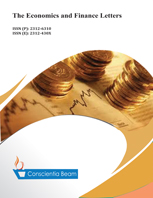Exchange Rate Volatility, Foreign Exchange Market Intervention and Asymmetric Preferences
DOI:
https://doi.org/10.18488/journal.29.2019.62.203.209Abstract
Policymakers in emerging market economies intervene in currency markets to counter appreciation or depreciation pressure, while also responding to the degree of exchange rate volatility. This paper investigates whether the asymmetric response in terms of foreign exchange intervention depends on the degree of exchange rate volatility. Specifically, we estimate whether the response by policymakers to currency market conditions differs in above or below threshold levels of volatility. We use dynamic threshold panel analysis presented within an asymmetric policy reaction function to investigate the role of exchange rate volatility in foreign exchange intervention. We estimate the model using Generalized Method of Moments (GMM) with monthly data for 23 emerging market economies from 2000 to 2016. We find that the asymmetric aversion to appreciation only holds under below-threshold volatility scenarios, and that the majority of the time, policymakers are simply leaning against exchange rate movements to ensure stable exchange rate conditions. The results confirm that exchange rate volatility impacts the response of policymakers to exchange rate conditions.

